towing CHEVROLET CAMARO 1994 4.G Owners Manual
[x] Cancel search | Manufacturer: CHEVROLET, Model Year: 1994, Model line: CAMARO, Model: CHEVROLET CAMARO 1994 4.GPages: 292, PDF Size: 15.35 MB
Page 59 of 292
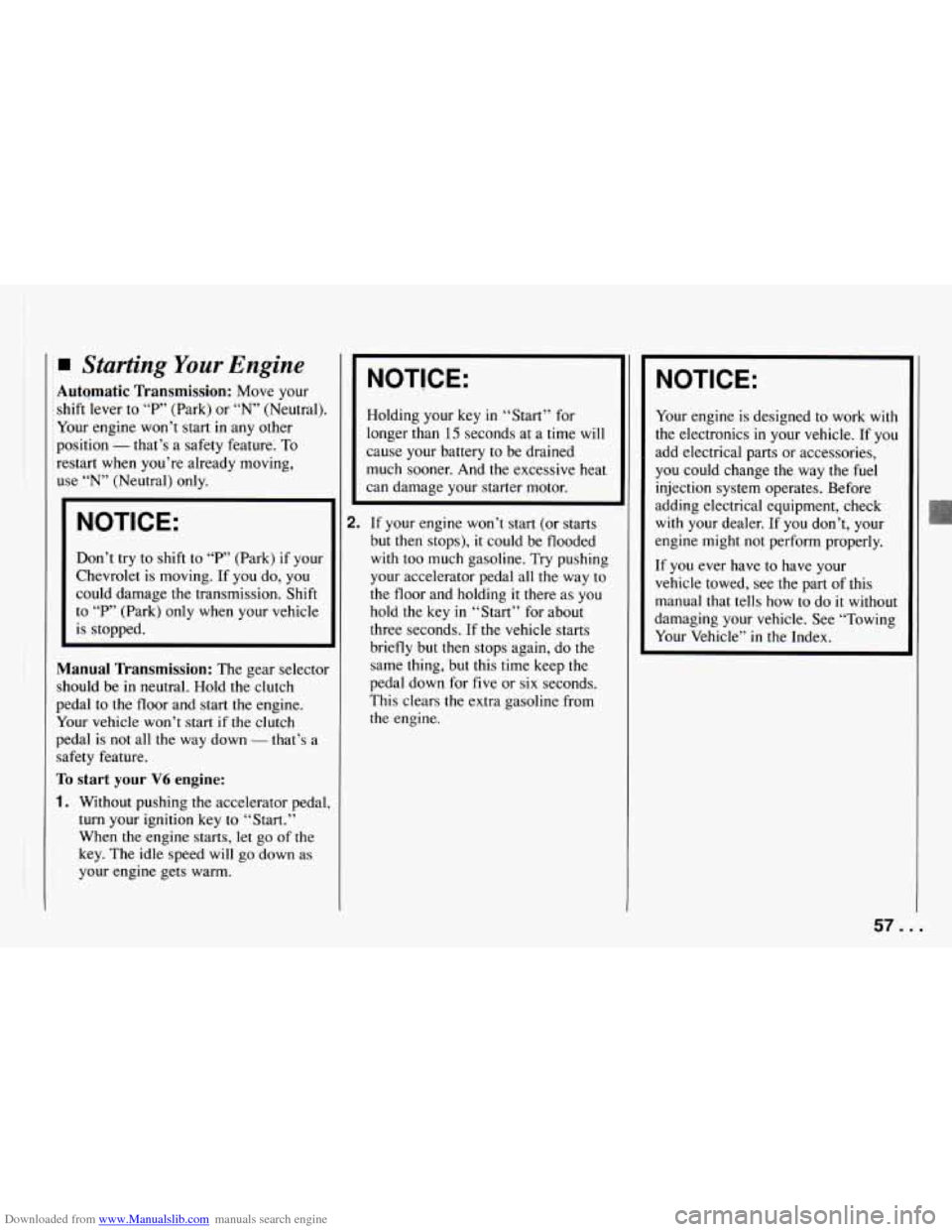
Downloaded from www.Manualslib.com manuals search engine Starting Your Engine
Autamatic Transmission: Move your
shift lever to
“P” (Park) or “N’ (Neutral).
Your engine won’t start
in any other
position
- that’s a safety feature. To
restart when you’re already moving,
use
“N’ (Neutral) only.
NOTICE:
Don’t try to shift to “P’ (Park) if your
Chevrolet is moving. If you do, you
could damage
the transmission. Shift
to
“P” (Park) only when your vehicle
is stopped.
Manual Transmission: The gear selector
should be in neutral. Hold the clutch
pedal to the floor and start the engine.
Your vehicle won’t start if
the clutch
pedal is not all the way down
- that’s a
safety feature.
To start your V6 engine:
NOTICE:
Holding your key in “Start” for
longer than
15 seconds at a time will
cause your battery to be drained
much sooner. And the excessive heat
can damage your starter motor.
2. If your engine won’t start (or starts
but then stops),
it could be flooded
with too much gasoline. Try pushing
your accelerator pedal all the way to
the floor and holding
it there as you
hold the key in “Start” for about
three seconds. If the vehicle starts
briefly but then stops again, do the
same thing, but this time keep the
pedal down for five or
six seconds.
This clears the extra gasoline from
the engine.
NOTICE:
Your engine is designed to work with
the electronics
in your vehicle. If you
add electrical parts or accessories,
you could change the way the
fuel
injection system operates. Before
adding electrical equipment, check
with your dealer. If you don’t, your
engine might not perform properly.
If you ever have to have your
vehicle towed, see the part of this
manual that tells how to do
it without
damaging your vehicle. See “Towing
Your Vehicle”
in the Index.
1. Without pushing the accelerator pedal
turn your ignition
key to “Start.”
When
the engine starts, let go of the
key. The idle speed will
go down as
your engine gets warm.
57.
Page 60 of 292
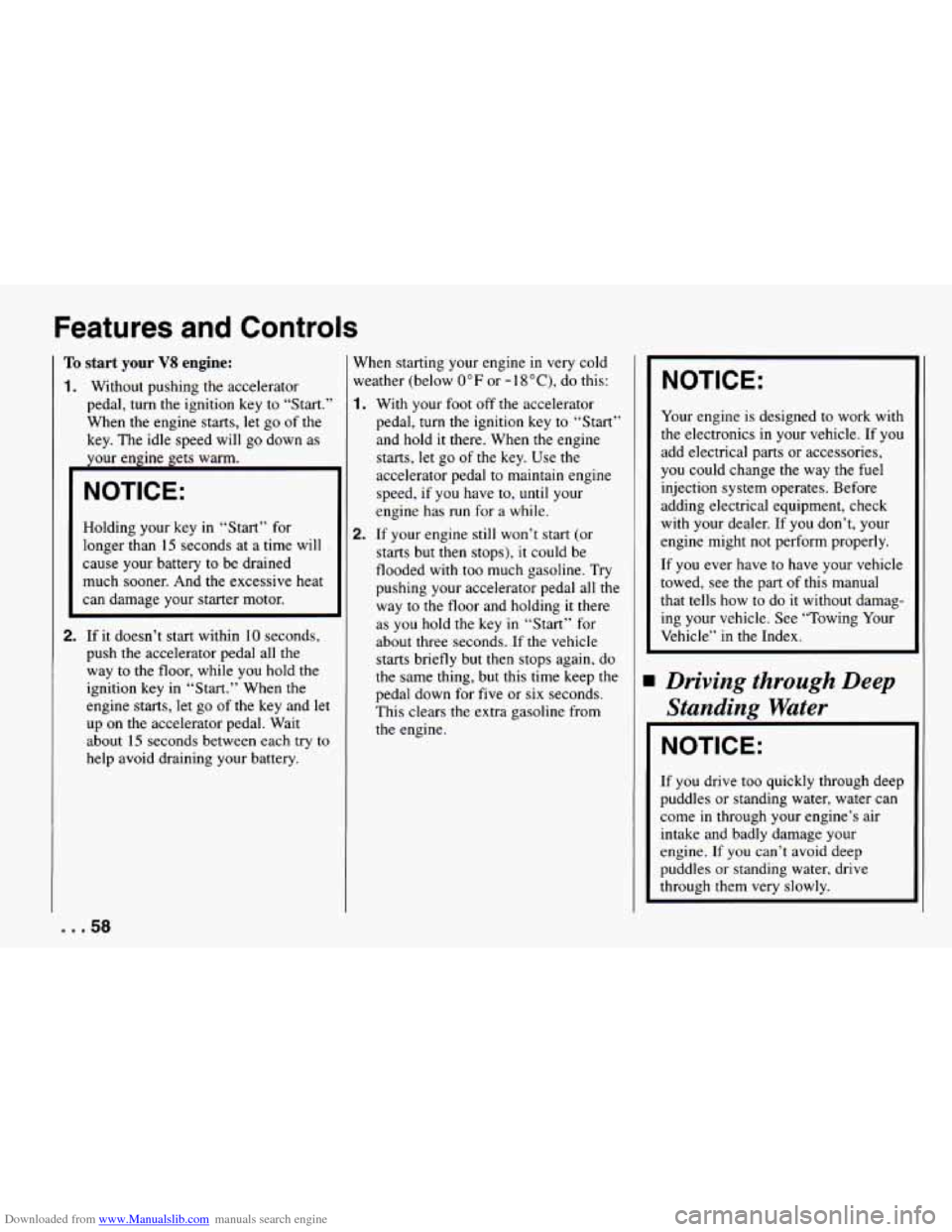
Downloaded from www.Manualslib.com manuals search engine Features and Controls
To start your V8 engine:
1. Without pushing the accelerator
pedal,
turn the ignition key to “Start.”
When the engine starts, let go of the
key. The idle speed will go down as
your engine gets warm.
NOTICE:
Holding your key in “Start” for
longer than
15 seconds at a time will
cause your battery to be drained
much sooner. And
the excessive heat
can damage your starter motor.
2. If it doesn’t start within 10 seconds,
push the accelerator pedal all the
way to the floor, while you hold the
ignition key in “Start.” When the
engine starts,
let go of the key and let
up on the accelerator pedal. Wait
about
15 seconds between each try to
help avoid draining your battery. When starting
your engine
in very cold
weather (below
0°F or -18”C), do this:
1.
2.
With your foot off the accelerator
pedal,
turn the ignition key to “Start”
and hold it there. When the engine
starts, let go of the key. Use the
accelerator pedal to maintain engine
speed, if you have to,
until your
engine has
run for a while.
If your engine still won’t start (or
starts but then stops),
it could be
flooded
with too much gasoline. Try
pushing your accelerator pedal all the
way to the floor and holding
it there
as you hold the key
in “Start” for
about three seconds. If the vehicle
starts briefly but then stops again, do
the same thing, but this time keep the
pedal down for
five or six seconds.
This clears the extra gasoline from
the engine.
NOTICE:
Your engine is designed to work with
the electronics in your vehicle. If you
add electrical parts or accessories,
you could change the way
the fuel
injection system operates. Before
adding electrical equipment, check
with your dealer. If you don’t, your
engine might not perform properly.
If you ever have to have your vehicle
towed, see the
part of this manual
that tells how to do it without damag-
ing your vehicle. See “Towing Your
Vehicle” in the Index.
Driving through Deep
Standing Water
NOTICE:
If you drive too quickly through deep
puddles or standing water, water can
come in through your engine’s air
intake and badly damage your
engine. If
you can’t avoid deep
puddles or standing water, drive
through them very slowly.
... 58
Page 63 of 292
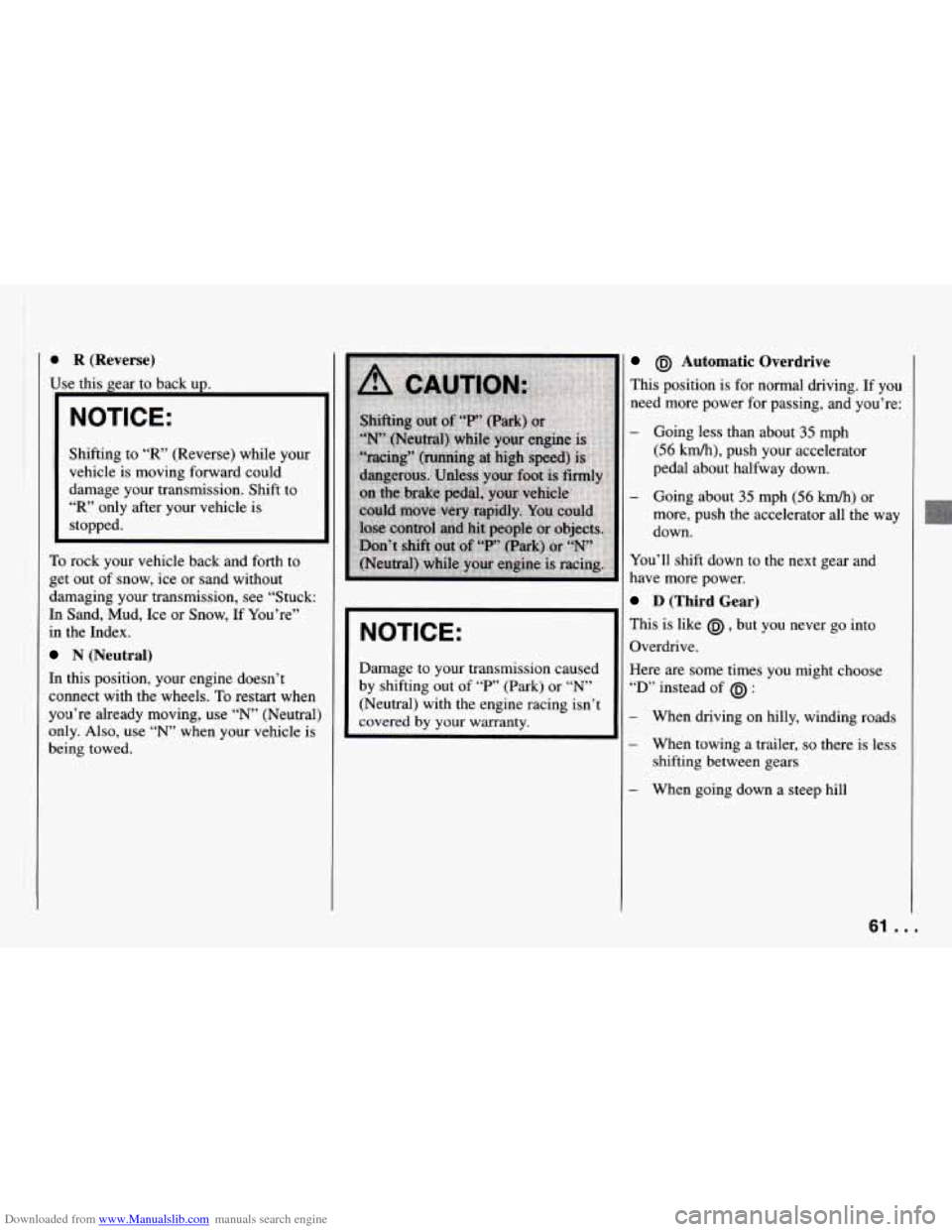
Downloaded from www.Manualslib.com manuals search engine i
0 R (Reverse)
$e this gear to back up.
NOTICE:
Shifting to “R’ (Reverse) while your
vehicle is moving forward could
damage your transmission. Shift to
“R’ only after your vehicle is
stopped.
To rock your vehicle back and forth to
get out of snow, ice or sand without
damaging your transmission, see “Stuck:
In Sand, Mud, Ice or Snow, If You’re’’
in the Index.
N (Neutral)
In this position, your engine doesn’t
connect with the wheels.
To restart when
you’re already moving, use
“N” (Neutral)
only. Also,
use “N” when your vehicle is
being towed.
NOTICE:
Damage to your transmission caused
by shifting out of
“P’ (Park) or “N’
(Neutral) with the engine racing isn’t
covered by your warranty.
@J Automatic Overdrive
This position is for normal driving. If you
need more power for passing,
and you’re:
- Going less than about 35 mph
(56 km/h), push your accelerator
pedal about halfway down.
- Going about 35 mph (56 km/h) or
more, push the accelerator all the way
down.
You’ll shift down to the next gear and
have more power.
D (Third Gear)
This is like @ , but you never go into
Overdrive.
Here are some times
you might choose
“D’ instead of @J :
When driving on hilly, winding roads
When towing a trailer,
so there is less
shifting between gears
When going down a steep hill
61 ...
Page 69 of 292
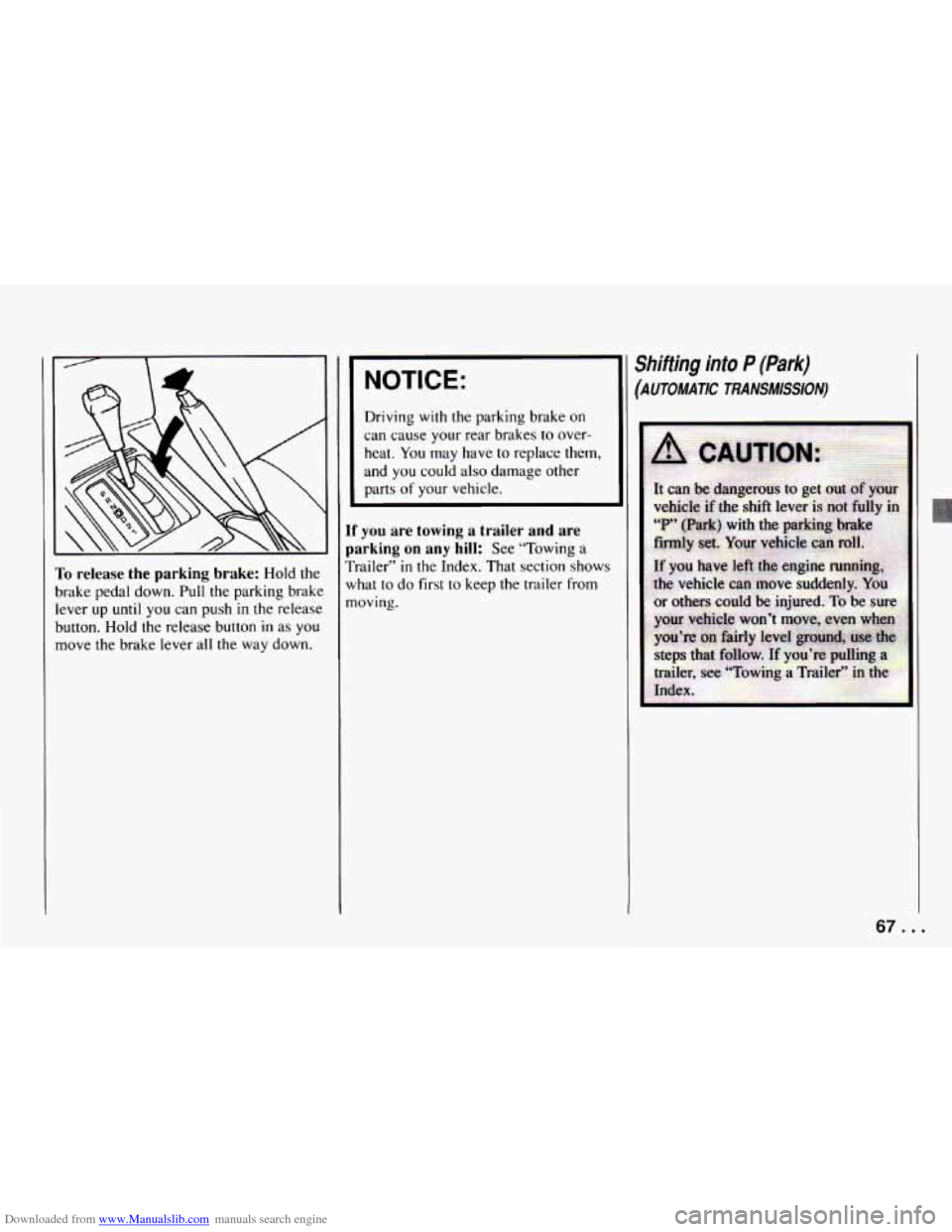
Downloaded from www.Manualslib.com manuals search engine ~ ~ ~~~ ib release the parking brake: Hold the
rake pedal down.
Pull the parking brake
zver
up until you can push in the release
wtton.
Hold the release button in as you
nove the brake lever all
the way down.
NOTICE:
Driving with the parking brake on
can cause your rear brakes to over-
heat.
You may have to replace them,
and you could also damage other
parts of your vehicle.
If you are towing a trailer and are
parking on any hill:
See “Towing a
Trailer”
in the Index. That section shows
what
to do first to keep the trailer from
moving.
Shifting into P (Park)
(AUTOMATIC TRANSMISSION)
67. .
Page 71 of 292
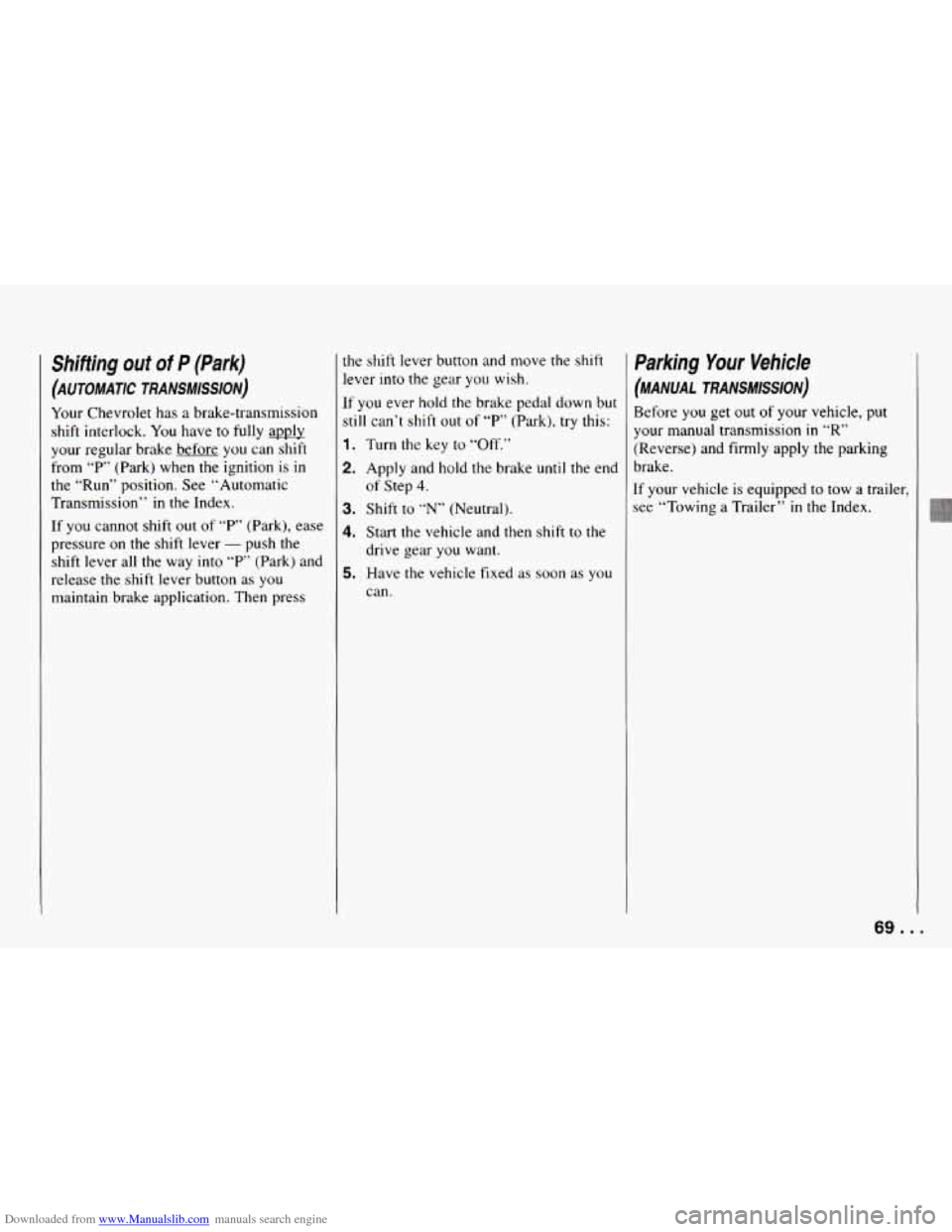
Downloaded from www.Manualslib.com manuals search engine Shifting out of P (Park)
[AUTOMATIC TRANSMISSION)
Your Chevrolet has a brake-transmission
shift interlock.
You have to fully apply
your regular brake before
you can shift
from
“P’ (Park) when the ignition is in
the
“Run” position. See “Automatic
Transmission” in the Index.
If you cannot shift out of “P’ (Park), ease
pressure on the shift lever
- push the
shift lever all the way into
“P’ (Park) and
release the shift lever button
as you
maintain brake application. Then press the
shift lever button and move the shift
lever into the gear you wish.
If you ever hold the brake pedal down but
still can’t shift out of “P” (Park), try this:
1. Turn the key to ‘bOff.”
2. Apply and hold the brake until the end
3. Shift to “N” (Neutral).
4. Start the vehicle and then shift to the
drive gear
you want.
of Step 4.
5. Have the vehicle fixed as soon as you
can.
Parking Your Vehicle
(MANUAL TRANSMISSION)
Before you get out of your vehicle, put
your
manual transmission in “R”
(Reverse) and firmly apply the parking
brake.
If your vehicle is equipped to tow a trailer,
see “Towing a Trailer”
in the Index.
69 ...
Page 73 of 292
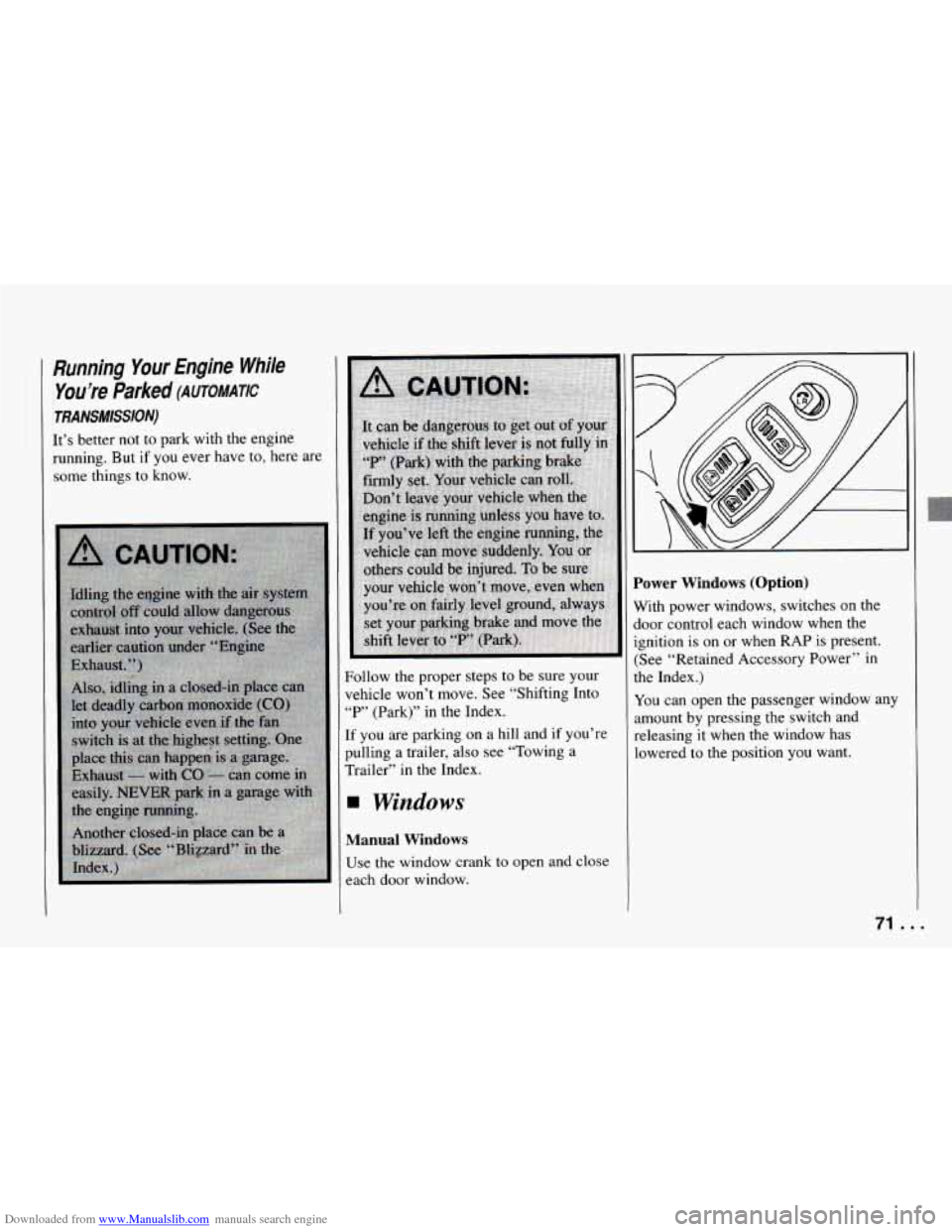
Downloaded from www.Manualslib.com manuals search engine Running Your Engine While You’re Parked
(AUTOMATIC
TRANSMISSION)
It’s better not to park with the engine
running. But if you ever have to, here are
some things to know.
Follow the proper steps to be sure your
vehicle won’t move. See “Shifting Into
“P’ (Park)” in the Index.
If
you are parking on a hill and if you’re
pulling a trailer, also see “Towing a
Trailer” in the Index.
Windows
Manual Windows
Use the window crank to open and close
each door window.
?ower Windows (Option)
Nith power windows, switches on the
loor control each window when the
gnition is
on or when RAP is present.
:See “Retained Accessory Power” in
he Index.)
Y‘ou can open the passenger window any
imount by pressing the switch and
-eleasing it when the window has
owered to the position you want.
74
Page 97 of 292
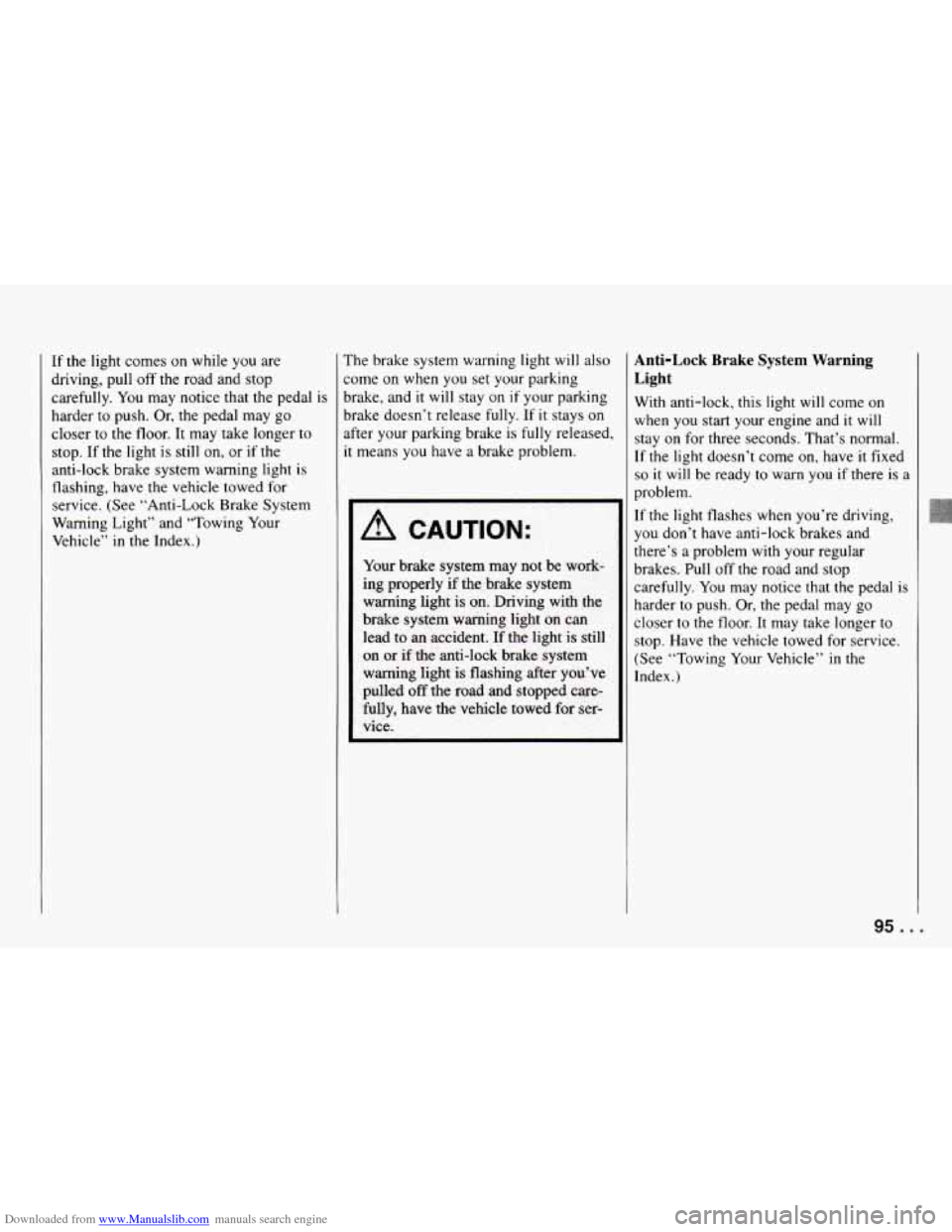
Downloaded from www.Manualslib.com manuals search engine If the light comes on while you are
driving, pull off the road and stop
carefully.
You may notice that the pedal is
harder to push. Or, the pedal may go
closer to the floor. It may take longer to
stop. If the light is still on, or
if the
anti-lock brake system warning light is
flashing, have the vehicle towed for
service. (See “Anti-Lock Brake System
Warning Light” and “Towing Your
Vehicle”
in the Index.) The
brake system warning light
will also
come on when you set your parking
brake, and
it will stay on if your parking
brake doesn’t release
fully. If it stays on
after your parking brake is
fully released,
it means you have a brake problem.
A CAUTION:
Your brake system may not be work-
ing properly if the brake system
warning light
is on. Driving with the
brake system warning light on can
lead to an accident. If &e light is still
on or if the anti-lock brake system
warning light is flashing after
you’ve
pulled off the road and stopped care-
fully, have the vehicle towed
for ser-
vice.
Anti-Lock Brake System Warning Light
With anti-lock, this light will come on
when you start your engine and
it will
stay on for three seconds. That’s normal.
If the light doesn’t come on, have it fixed
so it will be ready to warn you if there is a
problem.
If the light flashes when you’re driving,
you don’t have anti-lock brakes and
there’s a problem with your regular
brakes. Pull off the road and stop
carefully. You may notice that the pedal is
harder to push. Or, the pedal may go
closer to the floor. It may take longer to
stop. Have the vehicle towed for service.
(See “Towing Your Vehicle” in the
Index.)
95 ...
Page 125 of 292
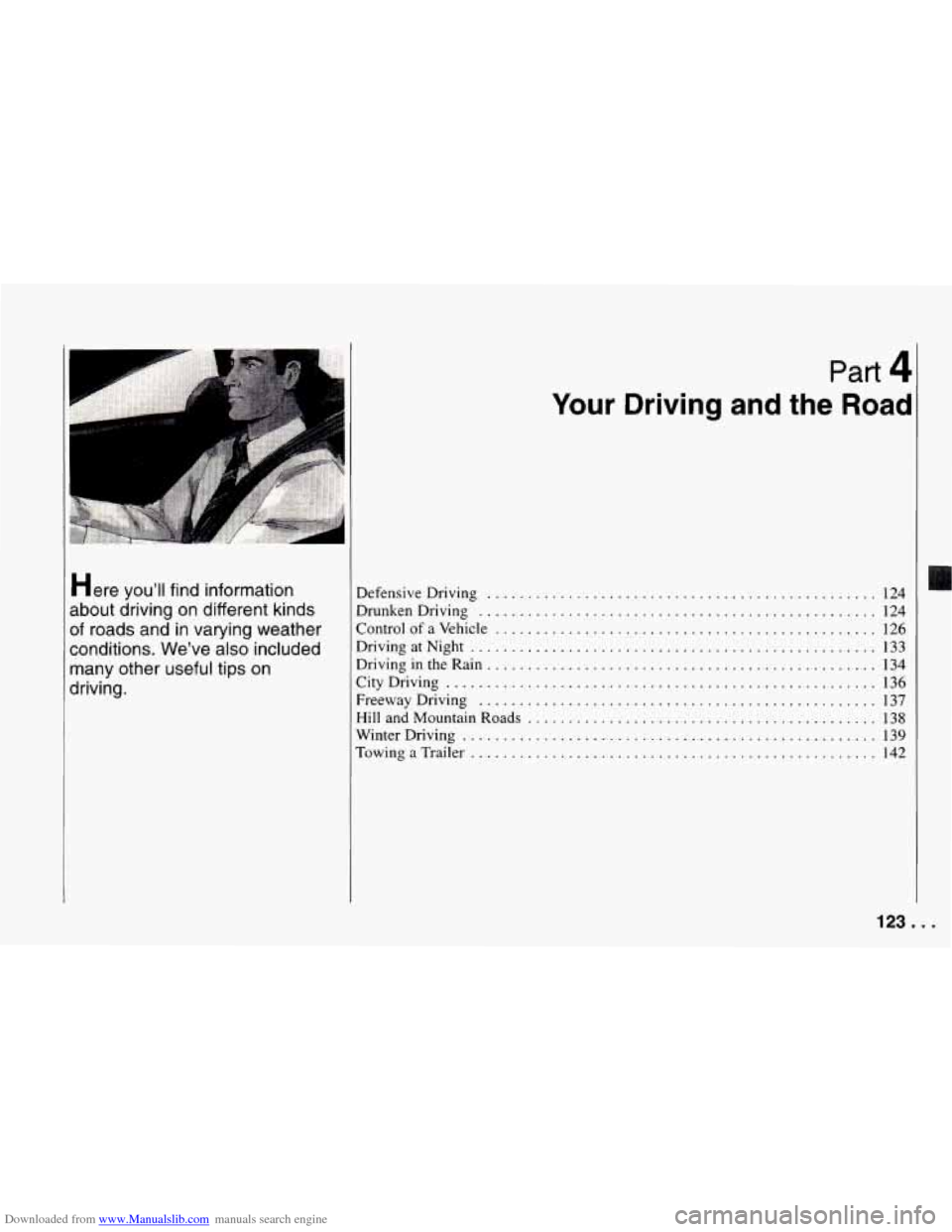
Downloaded from www.Manualslib.com manuals search engine Part 4
Here you’ll find information
about driving on different kinds of roads and in varying weather
conditions. We’ve also included
many other useful tips on
driving.
I
I
I
Your Driving and the Road
DefensiveDriving ................................................ 124
DrunkenDriving
................................................. 124
Control
of a Vehicle , . . . . . . . . . . . . . . . . . . . . . . . . . . . . - . . . . . . . . . . . . . . . . . 126
DrivingatNight
.................................................. 133
Driving in the Rain
. . . . . . . . . . . . . . . . . . . . . . . . . . . . . . . . . . . . . . . . . . . . . . . . 134
CityDriving
..................................................... 136
FreewayDriving
................................................. 137
Hill and Mountain Roads . . . . . . . . . . . . . . . . . . . . . . . . .
. . . . . . . . . . . . . . . . . . 138
WinterDriving
................................................... 139
TowingaTrailer
.................................................. 142
123 ...
Page 144 of 292
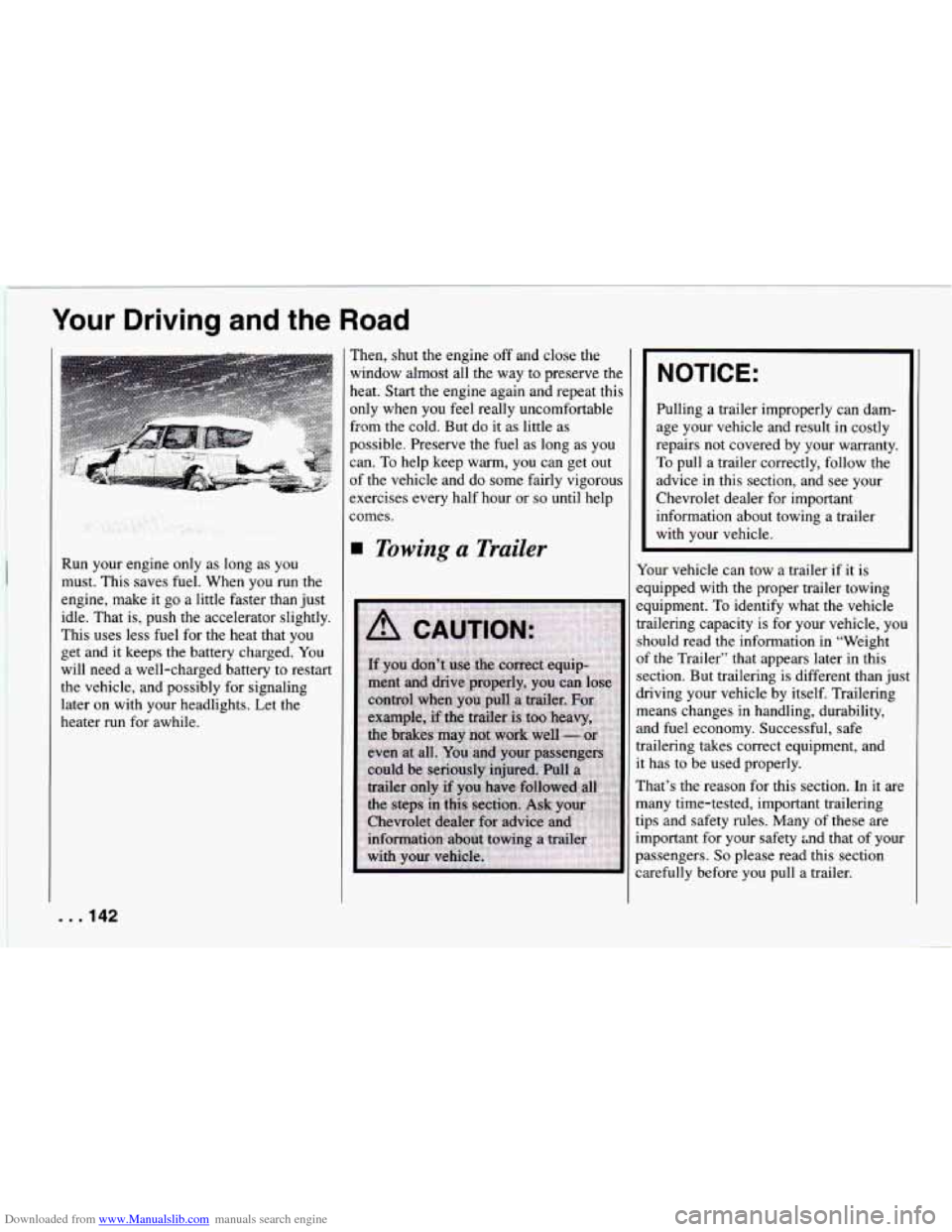
Downloaded from www.Manualslib.com manuals search engine Your Driving and the Road
Run your engine only as long as you
must. This saves fuel. When you run the
engine, make it go a little faster than just
idle. That is, push the accelerator slightly.
This uses less fuel for the heat that you
get and it keeps the battery charged.
You
will need a well-charged battery to restart
the vehicle, and possibly for signaling
later on with your headlights. Let the
heater run for awhile. Then,
shut the engine
off and close the
window almost all the way to preserve the
heat. Start the engine again and repeat this
only when you feel really uncomfortable
from the cold. But do it as little as
possible. Preserve the fuel as long as you
can. To help keep warm, you can get out
of the vehicle and do some fairly vigorous
exercises every half hour or
so until help
comes.
Towing a Trailer
NOTICE:
Pulling a trailer improperly can dam-
age your vehicle and result in costly
repairs not covered
by your warranty.
To pull a trailer correctly, follow the
advice
in this section, and see your
Chevrolet dealer for important
information about towing a trailer
with your vehicle.
Your vehicle can tow a trailer if it is
equipped with the proper trailer towing
equipment. To identify what the vehicle
trailering capacity is for your vehicle, you
should read the information in “Weight
of the Trailer” that appears later in this
section. But trailering is different than just
driving your vehicle by itself. Trailering
means changes in handling, durability,
and fuel economy. Successful, safe
trailering takes correct equipment, and
it has to be used properly.
That’s the reason for this section. In it are
many time-tested, important trailering
tips and safety rules. Many of these are
important for your safety md that of your
passengers.
So please read this section
carefully before you pull a trailer.
. . .142
Page 145 of 292
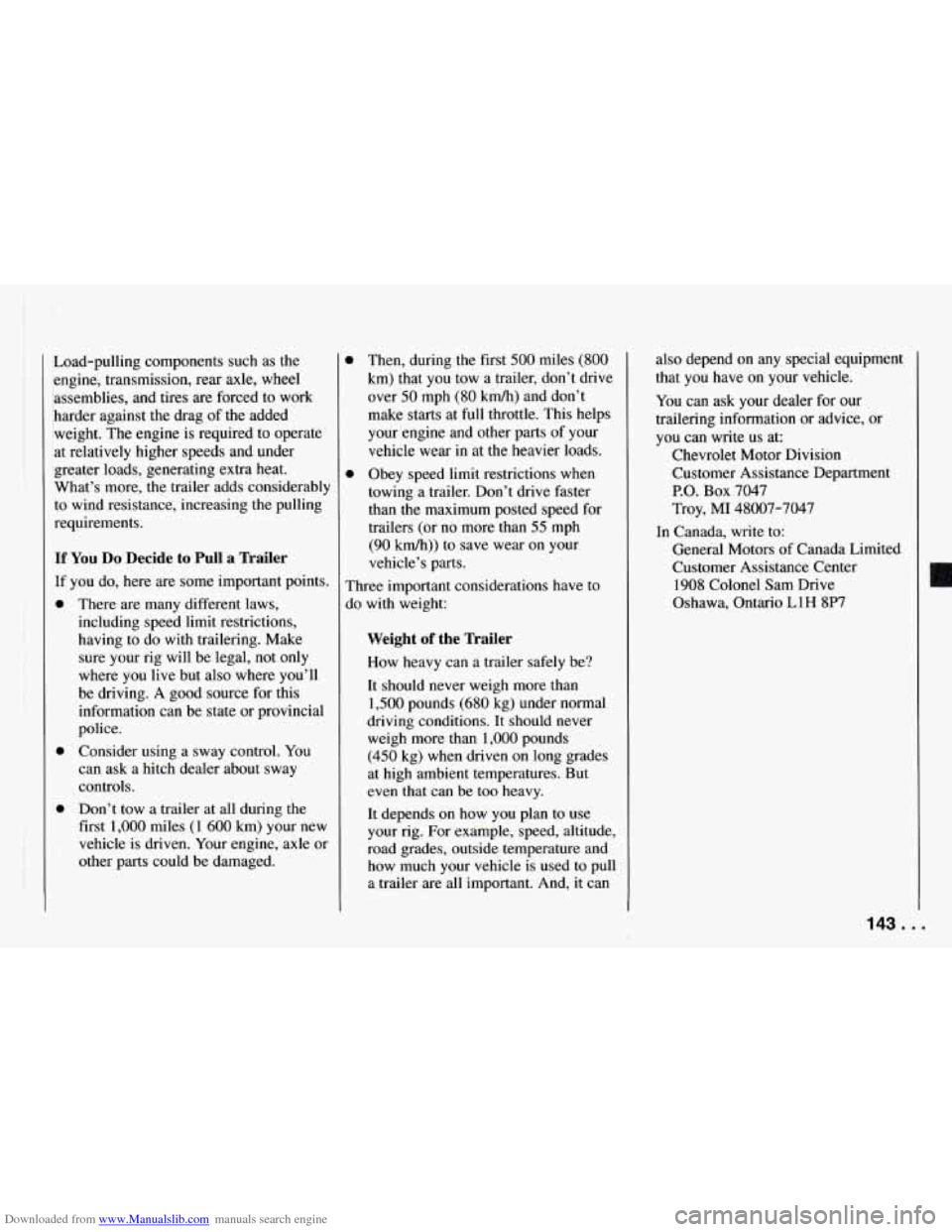
Downloaded from www.Manualslib.com manuals search engine t
Load-pulling components such as the
engine, transmission, rear axle, wheel
assemblies, and tires are forced to work
harder against the drag
of the added
weight, The engine
is required to operate
at relatively higher speeds and under
greater loads, generating extra heat.
What’s more, the trailer adds considerably
to wind resistance, increasing the pulling
requirements.
If You Do Decide to Pull a Trailer
If you do, here are some important points.
0
0
0
There are many different laws,
including speed limit restrictions,
having to do with trailering. Make
sure your rig will be legal, not only
where you live but also where you’ll
be driving. A good source for this
information can be state or provincial
police.
Consider using a sway control.
You
can ask a hitch dealer about sway
controls.
Don’t tow a trailer at all during the
first
1,000 miles (1 600 km) your new
vehicle is driven. Your engine, axle or
other parts could be damaged. Then, during
the first
500 miles (800
km) that you tow a trailer, don’t drive
over
50 mph (80 km/h) and don’t
make starts at full throttle. This helps
your engine and other parts of your
vehicle wear in at the heavier loads.
Obey speed limit restrictions when
towing a trailer. Don’t drive faster
than the maximum posted speed for
trailers (or no more than
55 mph
(90 km/h)) to save wear on your
vehicle’s parts.
Three important considerations have to
do with weight:
Weight of the Trailer
How heavy can a trailer safely be? also depend on
any special equipment
I
that you have on your vehicle.
You can ask your dealer for our
trailering information or advice, or
you can write
us at:
Chevrolet Motor Division Customer Assistance Department
P.O. Box 7047
Troy, MI 48007-7047
General Motors
of Canada Limited
Customer Assistance Center
1908 Colonel Sam Drive
Oshawa, Ontario
LlH 8P7
In Canada, write to:
It should never weigh more than
1,500 pounds (680 kg) under normal
driving conditions.
It should never
weigh more than
1,000 pounds
(450 kg) when driven on long grades
at high ambient temperatures. But
even that can be
too heavy.
It depends on how you plan to use
your rig. For example, speed, altitude,
road grades, outside temperature and
how much your vehicle is used to pull
a trailer are all important. And, it can
143. ..